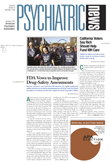Clinical Director, Otter Creek Associates, 1987-
Trustee-at-Large, APA Board of Trustees, 2002-
Chair, APA Council on Children, Adolescents, and Their Families, 1997-2002
Representative, Vermont Psychiatric Association, APA Assembly, 1990-96
Clinical Associate Professor, University of Vermont College of Medicine, 1994-
Recipient, Green Ribbon Award for Advocacy and Public Education, National Mental Health Association, 2000
I am a child and adolescent psychiatrist practicing in Burlington, Vt. I am also a clinical associate professor of psychiatry at the University of Vermont, College of Medicine. On a local level, I serve as the treasurer of the Vermont Psychiatric Association and as President of the Vermont Association of Child and Adolescent Psychiatry.
It has been an honor to serve as trustee-at-large for the past three years. In this capacity, I have tried to focus on advocating for our members and our patients. I have served as a spokesperson for APA on a wide variety of clinical and research issues, including children and medication, emotional reactions to war and terrorism, the juvenile death penalty, and enhancing access to data from clinical trials. I have also testified on our behalf before the FDA and several congressional committees. As vice chair of our delegation to the AMA House of Delegates, I initiated the proposal to eliminate “shadowing” by pharmaceutical sales reps. I also offered a resolution on the accuracy, validity, and reliability of scientific research. This resolution led the AMA to call for the development of a national registry of clinical trials, an initiative that quickly gained wide-spread support.
As a member of the APA Board, I helped develop the “Vision for Our Nation's Mental Health System,” our response to the report of the President's New Freedom Commission on Mental Health. As a trustee-at-large, I've also tried to enhance the collaboration and coordination between APA and other allied and advocacy organizations. In particular, I have worked with APA to develop joint testimony, amicus briefs, and position statements with the American Academy of Child and Adolescent Psychiatry, the American Academy of Psychiatry and the Law, the American Medical Association, the American Society for Adolescent Psychiatry, and the National Alliance for the Mentally Ill. I believe that such partnerships and joint efforts enhance our ability to achieve our larger goals and objectives.
My current priorities for APA are as follows:
Hold the line on dues and revisit joint dues proposals with our allied organizations.
Make APA more accessible and responsive to members with questions or problems.
Expand our support to the district branches to deal proactively with state and local issues.
Strengthen our ties with advocacy organizations.
I also believe it's entirely appropriate for APA to become involved with the larger social and political issues that face our society. How can we hope to deal effectively with chronic mental illness without addressing homelessness and poverty? How can we discuss “parity,”“ reimbursement,” or “integrated systems of care” without seriously exploring options like “universal access” or“ single payer” models? And how can we do our work without considering the emotional and economic impact of terrorism and war on our patients, our colleagues, and our society as a whole?
I have very much enjoyed serving on the Board of APA. I believe I have been a consistent and effective spokesperson and advocate for the organization. I am honored to be running for re-election to this position, and I'd welcome the opportunity to continue my efforts on behalf of our members, our patients, and our profession.
Primary Professional Activities and Sources of Income
Professional Activities
50%—Private practice 30%—Hospital and community consultation 20%—Teaching and volunteer work for psychiatric associations and advocacy organizations
Income
60%—Private practice (clinical and administrative activities) 40%—Hospital and community consultation

